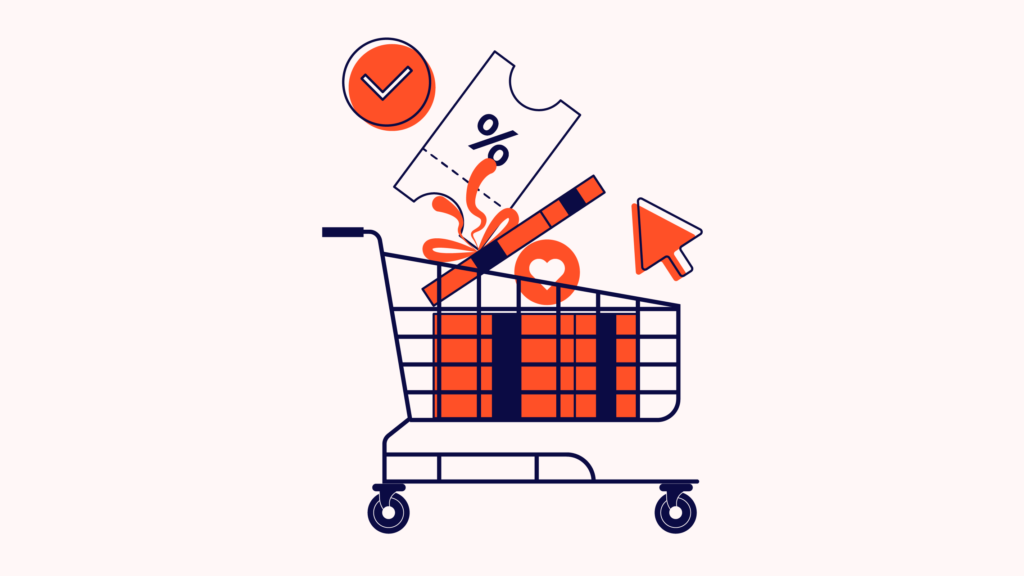What's a shopping cart in ecommerce? It's a big deal, but do you know what you do with it when setting up the checkout page?
Turning site visitors into paying customers is the difference between a successful ecommerce business and a hobby costing you money on web hosting. The point of sale at your online store is the shopping cart, and there's a right way to set that up for better conversion rates.
Knowing your way around a shopping cart in ecommerce streamlines your checkout process, makes your site more productive per visit, and results in more sales from customers who might have otherwise left your site without making a purchase.
In this article, we will look over this underrated piece of software. We'll talk about the two main types of ecommerce shopping cart, what they're good for, and why you might pick one payment gateway over another.
How Does a Shopping Cart Work for Customers?
A shopping cart in ecommerce is a customizable software that lets you take payments from customers at your online store. This is usually built around credit card payments, but it can also take debit, PayPal, Apple Pay, and any other methods you can think of. When a visitor to your website goes to pay for the items on their list, the shopping cart is just the user-friendly front end with the functionality to process a payment.
At its most basic, your shopping cart software is just a block of code that you can plug into the source code for your ecommerce site. Depending on how well your developer has engineered the back end, the products site visitors pick out feed into the back-end database, building a shopping list ready when it's time to check out.
A user-friendly shopping cart appears as a happy little icon that can be accessed from any page on your site, cheerfully waiting for the customer to make the purchase decision and click through to payment processing. Click on that link, and it takes the customer straight through to a convenient checkout process that completes the sale.
Walmart does this beautifully with its pickup and delivery apps. As the customer moves toward the payment process, the system uses a few marketing tools for upselling them on the way out.
For example, the system takes a moment to show product pages for items the customer might be interested in but hasn't added to their list yet. Looking over recommended extras is part of the customer experience Walmart creates for everyone, and it functions the same way as the impulse buy racks in a checkout line.
Types of Shopping Cart Software & How They Work on the Back End
There are two basic online shopping cart software types: hosted and licensed.
These are just terms to describe the general structure of the shopping cart solution you're using, and there's a lot of variation within each type. Depending on the vendor, some are open source, while others are proprietary. Some are à-la-carte packages you get for a single upfront cost, while, increasingly, others are offered for a monthly fee.
Which one you pick is up to you, though a small business will have different parameters from a bigger ecommerce platform, so your needs might change as you grow. Don't be shy about reassessing your shopping cart every few months or once a year.
Here's a breakdown of the two main types of shopping carts.
Hosted shopping cart
Hosted shopping carts are offered as SaaS packages from third-party vendors. In this model, your online shopping cart is hosted on a remote server and accessed as a normal part of the page-loading process. In effect, a hosted shopping cart feeds from the remote server into the code for your website as an add-on, and payment information is run back through a secure processor.
This is a great choice for a small business and someone who wants low-hassle credit card processing options. Self-hosted online shopping carts offer way higher functionality than something you cobble together on your own with lots of cart features and standard templates you can optimize for your type of inventory. They also usually come with top-tier encryption, tech support, and the latest security patches to avoid mishaps like the repeated and frankly ridiculous Amazon data breaches that have cost billions of dollars yet keep happening.
Licensed shopping cart
Licensed shopping carts are for bigger operations with the sophistication to handle a custom in-house solution. This is a software package you either buy wholesale and host on your server or have the IT guys build from scratch. It can be completely custom, and you can keep adding features until you've run out of ideas.
Have a problem with shopping cart abandonment? Build in a one-click option. Have a problem with shipping costs? Add a feature to bundle purchases into more efficient deliveries. Would you like to encourage this departing customer to come back soon? Slap on a button to follow your apps on social media or for a newsletter you use for email marketing. The sky's the limit here.
While having all kinds of features built into your cart is great, this option isn't for everybody. Ideally, you have a good developer in the IT room who can do something custom for you in a few days, but that's usually outside the range of a small business or new retailer.
Even if you have access to the best shopping cart software your tech people can build, abandoning the simplicity of a hosted shopping cart is usually for enterprise businesses or retailers with really complex tech stacks to work through.
Why Is an Ecommerce Shopping Cart Important for Your Business?
Your ecommerce store shopping cart is a powerful tool for customer management. A well-designed shopping cart encourages customers to build longer lists with more items, buy higher-margin items, and keep coming back. Here are some of the benefits of having a good shopping cart solution.
Improved cart abandonment rate
Let's say you're going over your site analytics and see something disturbing. Around 1 in 5 of your customers gets to the final checkout section of the shopping cart and then abandons their purchase.
This could be because they got sticker shock when they saw what their total cost would be. It could be that the process took too long, and they left. It could also be that they needed to remember something, navigated back to look for it, didn't find it, and then left your site instead of completing the purchase. Cart abandonment should be front of mind, always: why and at what rate is it happening?
Better navigation
You can solve all these problems with a better shopping cart page design. Solve the sticker shock like Amazon and Home Depot do by keeping a running tally of the cart price on the right navigation bar.
Streamlined checkout
Impatient customers can be dealt with by either streamlining the checkout, storing their cart for their next visit, or both. And Walmart's excellent shopping cart solves the forgot-the-eggs problem by asking if the customer would like anything else as part of the checkout.
All these integrations are available in both hosted and licensed shopping carts.
How to Choose the Right Ecommerce Shopping Cart Platform?
Start your search for the best shopping cart by deciding how you want it to work on the back end, hosted or licensed.
When you have that settled, look around for features you need in a cart, which will vary with your business type. You don't, for instance, need a delivery/store pickup button if your ecommerce business doesn't offer store pickup. Use common sense to pick a package with just the features you need.
How to Pick the Best Ecommerce Shopping Cart Solutions
You have many options for shopping carts for your online business. We built a handy list that goes over the best shopping cart solutions.
Get Your Ecommerce Business Rolling
All this is great information, but the industry keeps changing so fast it's hard to keep up with a one-off article. You need a constant, unending flow of news, advice, and updates about the latest and greatest in the world of ecommerce management.
Thankfully, there's an effortless way to do that: By subscribing to The Ecomm Manager newsletter, which delivers all our insights, tips, and how-to guides straight to your inbox. Sign up now, and we'll keep you updated on everything you need to know to keep your online store thriving.
More great ECM content:


